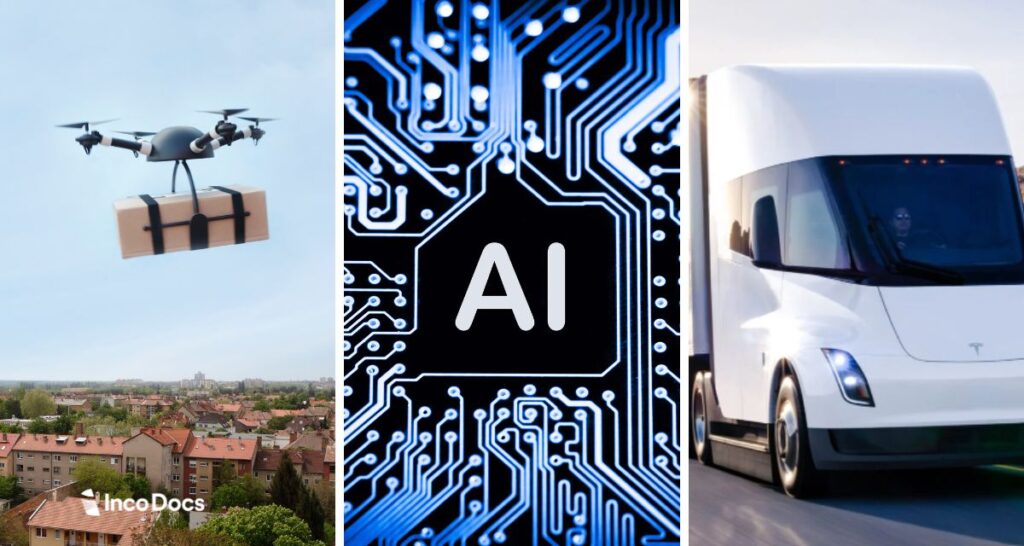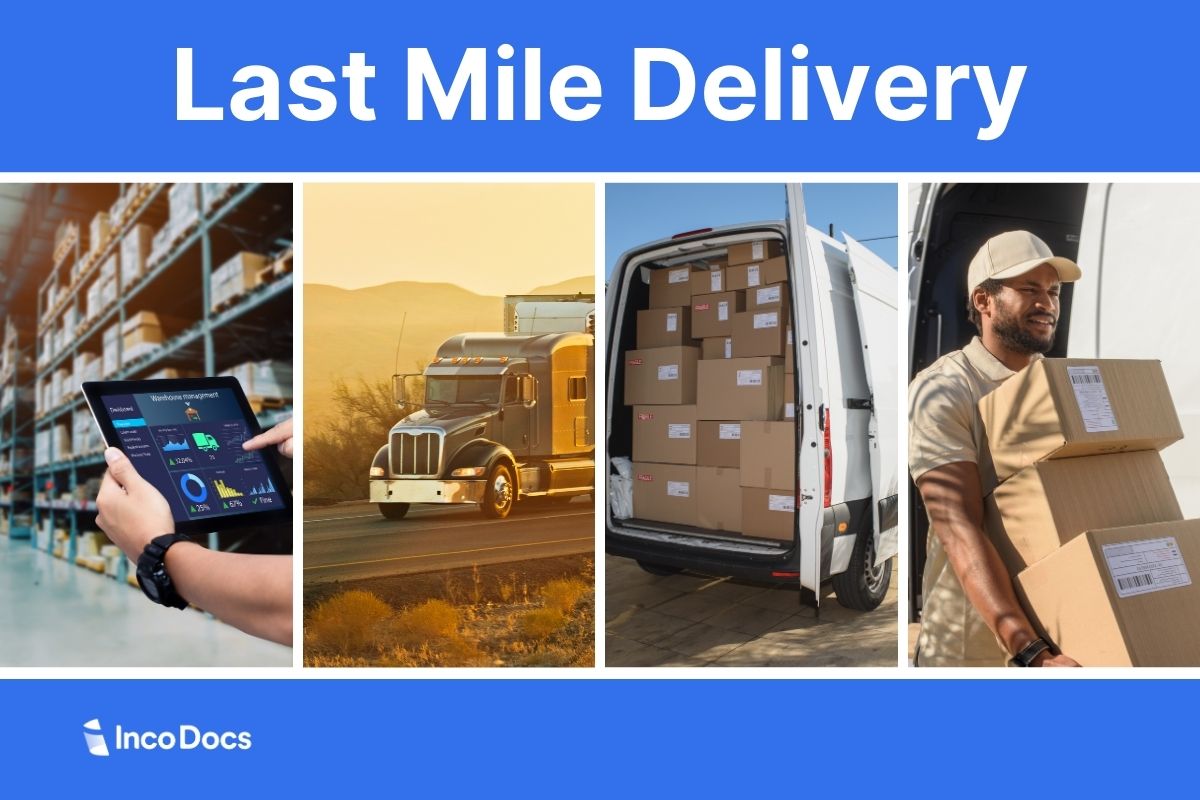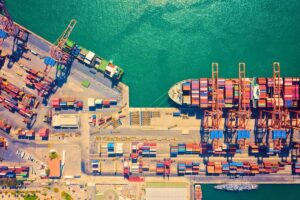Last mile delivery, also known as final mile, is the final step in the supply chain. Last mile is the transport of cargo from a transportation hub to their final destination, which can be a residential address, warehouse or a retail store.
In this article we will explain how last mile delivery works, issues faced during last mile delivery, and how companies can manage and streamline the last mile delivery process.
What Is Last Mile Delivery?
Last mile delivery is the final freight delivery along the supply chain. In the case of imported goods, once the goods have been cleared through customs, the freight is moved from the nearest freight depot, port or airport and delivered to the final destination. Last mile deliveries can be completed by trucks, vans, couriers and even drones, depending on the overall size and weight of the cargo.
This stage affects how fast orders arrive, how much delivery costs, and how happy customers are. Efficient last mile delivery can speed up shipping times and lower the total cost.
Why Last Mile Delivery Matters
It’s obvious that fast and reliable delivery improves the customer experience. In today’s world, people expect their orders to arrive quickly and without problems. A good delivery service makes customers happy and leads to positive reviews.
But when there are delays or mistakes, customers get frustrated. The last mile delivery problem happens when orders are late or mishandled at the final stage. This can lead to negative feedback and damage the company’s reputation.
To keep customers satisfied, businesses need to focus on making last mile delivery more efficient and cost-effective. Providing a dependable delivery service helps meet customer expectations and builds loyalty.
A good last mile delivery experience makes customers want to order again. When delivery is fast and smooth, people trust the service and are more likely to return. According to Honeywell, 84% of customers say they won’t shop with a retailer again if they have a poor last mile delivery experience.
The Last Mile Delivery Process for Imported Goods
There are plenty of parties that are connected to the last mile delivery process. Some of the parties include importers, freight forwarders, customs brokers, last mile delivery companies, 3PLs, couriers and warehouses, which all must work together to co-ordinate last mile deliveries.
Here’s an overview of how the last mile delivery process typically works after an international shipment reaches the country of import via seafreight or airfreight:
- Arrival at Port or Airport: After goods are unloaded, they enter customs clearance. Documentation such as the Bill of Lading or Airway Bill are verified and the applicable import duties and taxes are paid.
- Customs Clearance and Release: Once cleared through customs, the shipment is either moved to a bonded warehouse or is ready for transportation. Efficient communication between the customs broker, freight forwarder, and last mile provider is key to avoiding delays.
- Freight Consolidation or Direct Delivery: Depending on the shipment size and destination, the cargo may be consolidated with other shipments or sent directly to its final destination.
- Local Delivery and Routing: The cargo is assigned to a local freight provider that will handle the final last mile delivery. Route optimization will ensures that deliveries are made efficiently while keeping costs as low as possible.
- Final Delivery to the Business: The shipment is delivered to its final destination. In the case of incomplete addresses or access issues, there may be a need for redelivery, which can incur additional costs.
High costs are a major challenge in last mile delivery. The cost of fuel, labor, and infrastructure are key factors that drive up the final costs. Inefficient routes due to traffic congestion and long distances further increase delivery times and expenses. Poor route planning often leads to delays, adding to the overall cost of delivering packages to customers.
Another big issue is the lack of real-time visibility, making it hard to track shipments accurately. This causes frustration and uncertainty for both customers and businesses.
Today customers expect next day, or even same day deliveries. Meeting customer expectations for fast and free shipping also puts pressure on companies, especially when giants like Amazon set such high standards. For smaller businesses, matching these expectations can be tough and costly.
The Last Mile Problem Explained
The last mile problem refers to the challenge of delivering goods quickly and efficiently while keeping costs as low as possible. Businesses must balance customer demands for fast service with the limitations of their delivery operations. This issue becomes more complex as companies try to meet expectations for speedy and reliable deliveries.
The problem persists due to the rapid growth of e-commerce, which has led to a higher volume of deliveries. Urbanization adds to the difficulty, with traffic and accessibility issues slowing down drivers. At the same time, customer expectations for faster service continue to rise. Failed deliveries, often due to customers not being at home to receive a parcel, and the high costs of delivering to remote or densely populated areas make the last mile even more challenging.
Strategies for Success in Last Mile Delivery
Partnering with 3PLs
Partnering with third-party logistics providers (3PLs) and mail carriers can offer several advantages for businesses. By working with 3PLs, companies gain access to industry expertise and advanced technologies, helping them improve their delivery services. This approach also allows businesses to scale without needing large upfront investments, making it a cost-effective solution for managing growth.
Here are 5 common third-party logistics (3PL) companies:
DHL
A global leader in logistics, DHL offers a wide range of services including transportation, warehousing, and supply chain management.
XPO Logistics | Known for its innovative technology, XPO provides transportation and logistics services with a strong focus on last mile delivery solutions.
UPS Supply Chain Solutions | UPS offers comprehensive 3PL services including freight, warehousing, and supply chain consulting, leveraging its global network for efficient deliveries.
FedEx Supply Chain | A division of FedEx, this 3PL provider specializes in e-commerce fulfillment, transportation, and reverse logistics for businesses of all sizes.
C.H. Robinson | One of the largest logistics providers globally, C.H. Robinson offers flexible supply chain solutions, transportation services, and real-time tracking.
Consolidating Shipments
Consolidating shipments together to minimize the number of final deliveries will reduce last mile delivery costs, particularly for businesses shipping smaller quantities frequently.
Investing in Technology and Customer Communication
Investing in technology is another important strategy for success in last mile delivery. Using modern tools like delivery management software and customer communication platforms helps companies stay competitive. These tools streamline operations, improve tracking, and enhance overall customer service.
Enhancing delivery flexibility is key to meeting customer expectations. Offering options such as multiple delivery windows or alternative pickup locations gives customers more control over their deliveries.
Focusing on the customer experience is crucial for building loyalty. Clear communication through proactive updates and easy tracking resources keep customers informed and satisfied. Additionally, handling returns efficiently with a streamlined process strengthens trust and encourages repeat business.
Future Trends in Last Mile Delivery

As technology is quickly evolving, it’s opening doors for companies to look at new ways to optimize their last mile deliveries.
The Rise of AI and Machine Learning in Logistics
AI and machine learning have progressed considerably and are being utilized to improve last mile deliveries. These technologies help forecast demand and optimize inventory, leading to better decision-making and greater efficiency in delivery operations.
Urban Delivery Hubs
To meet customer demands, businesses are using local warehouses, lockers and micro-fulfilment centres located closer to urban areas to speed up delivery times. This not only makes deliveries faster but also gives companies a competitive edge.
Crowd Sourced Deliveries
While crowd-sourced companies are more common in domestic retail, we may start to see crowd-sourced solutions for larger shipments, offering flexible, on-demand last mile delivery options.
Autonomous Deliveries
Autonomous deliveries, such as autonomous cars, Tesla Semi Trucks and drones can cut the cost and time incurred in the last mile delivery stage. While drones deliveries are already being used for delivering urgent, high value products such as bloods and medication, as technology evolves it will provide more opportunities to be a suitable last mile option for a broader range of cargo.
RFID Tracking
Radio Frequency ID technology has evolved to make it a cost effective option to track cargo and deliveries. RFID technology can reveal patterns in last mile delivery routes, and also reduces the reliance on manual scanning delivery paperwork.
Staying Ahead in Last Mile Logistics
Staying ahead in last mile delivery means adopting the latest technologies, such as route optimization and real-time tracking, and looking at alternative vehicles to make final deliveries.
It’s also important to adapt to changing customer needs, like offering faster delivery options or flexible delivery windows. Businesses that continually refine their processes and focus on the customer experience will maintain a strong competitive edge. By improving last mile logistics, businesses can ensure that their imported goods arrive at their final destination on time, in good condition, and at the lowest possible cost.







